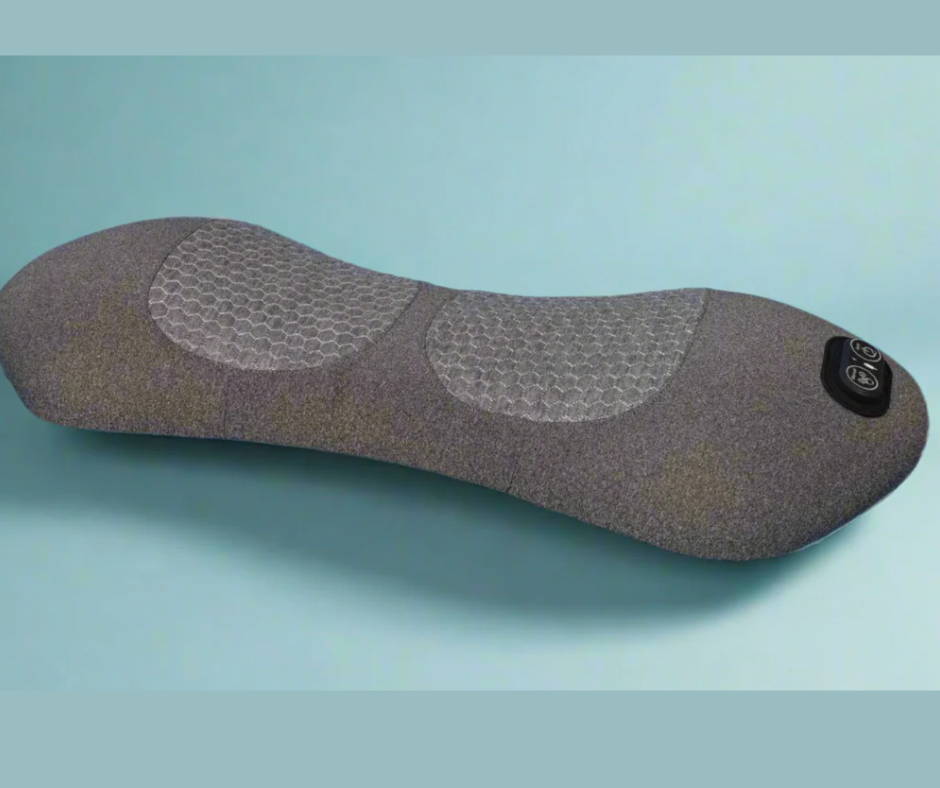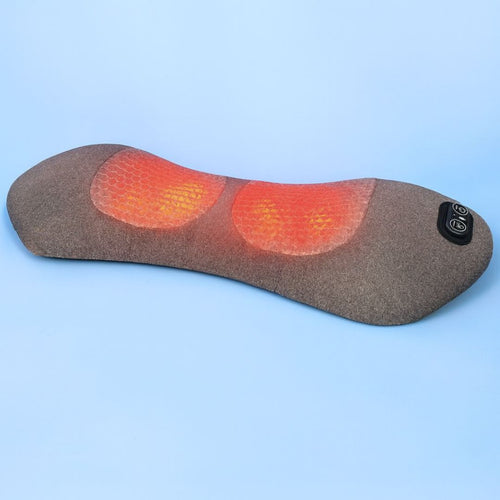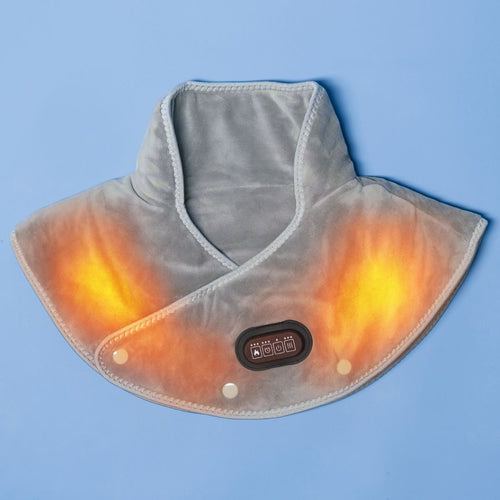10 Home Remedies for Shoulder Pain That Actually Work
By Holly Grace Callis | Published on August 4th, 2025

Shoulder pain is one of the most common issues people experience from everyday activities like sitting at a desk, reaching overhead, or carrying heavy bags. For many, the goal is to relieve pain at home without turning to medication. The right combination of rest, movement, and daily support can often ease discomfort and prevent future flare-ups.
In this article, we’ll cover 10 proven home remedies for shoulder pain.
You’ll learn how each method works, how to use them safely, and which supportive tools can help you feel more comfortable as you heal.
Common Causes of Shoulder Pain
You don’t have to be an athlete to experience shoulder pain. Every day habits, stress, and sleep position can all play a role. Understanding where your discomfort comes from helps you choose the right treatment.
-Overuse injuries: Tasks like lifting, reaching, or repetitive motion can strain shoulder muscles and tendons. Even typing or using a mouse all day can add up.
-Poor posture: Rounded shoulders and forward head position put extra pressure on your upper back and shoulder joints. This is common with prolonged sitting or screen time.
-Muscle tension or strain: Tight traps and rotator cuff muscles often come from chronic stress or long hours at a desk.
-Awkward sleep positions: Sleeping on your side without proper support can cause misalignment and next-day pain, especially in the shoulder joint and surrounding muscles.
Home Remedies for Shoulder Pain That Actually Work

Not every ache needs medication. Many shoulder issues respond well to consistent at-home care. These methods help reduce inflammation, ease tension, and improve mobility without relying on pills or procedures.
1. Heat Therapy for Muscle Relaxation
Applying heat is one of the most effective ways to calm stiff or sore shoulder muscles. A warm compress or heated massage device increases circulation and helps the muscles relax. This reduces the tightness that builds up from daily tension or overuse.
Using heat therapy once or twice a day can help lower pain and improve shoulder flexibility. Callixe’s heated Thera Pillow offers gentle warmth and cervical support, making it ideal for morning and evening routines.
2. Gentle Shoulder Mobility Exercises
Gentle movement helps maintain shoulder range of motion and prevents stiffness from getting worse. Start with simple moves like arm circles, wall crawls, and pendulum swings. These exercises activate the rotator cuff and surrounding muscles without strain.
It’s best to do mobility exercises after warming the area with heat. This makes muscles more responsive and helps prevent further irritation. Aim for short, regular sessions rather than long or intense workouts. The goal is smooth, pain-free movement.
3. Self-Massage or Trigger Point Tools
Tight knots in the shoulder area often come from repetitive motion or holding tension during the day. Self-massage tools can help release those trigger points. Using a massage ball or handheld device, apply steady pressure to areas around the shoulder blade, upper traps, and rotator cuff.
Focus on spots that feel sore or tender. Slowly roll or press into the tissue until the discomfort eases. For deeper relief, use a massage tool like the Thera Back to reach hard-to-target areas and support daily muscle recovery.
4. Posture Correction Throughout the Day
Slouching and rounded shoulders are a common cause of ongoing shoulder pain. When your posture shifts forward, it strains the muscles and joints in your upper back. Resetting your alignment during the day can help relieve that strain.
Using posture support tools like adjustable straps reminds your body to stay upright. These devices gently guide your shoulders into a more neutral position, reducing the buildup of stress and improving how your body feels over time.
5. Supportive Sleep Positioning
How you sleep affects how your shoulders feel the next day. Lying on the painful side can worsen inflammation and keep the joint from resting properly. Adjusting your sleep setup can help reduce pressure and support recovery.
Use a pillow that keeps your neck and spine in alignment without pushing the shoulder forward. Pillows like the Thera Pillow are designed to support the natural curve of your neck while giving your shoulders the space they need to relax. If needed, place a small pillow under your arm to maintain a neutral position.
6. Anti-Inflammatory Support
If swelling or soreness is part of your shoulder pain, natural anti-inflammatory tools may help. Herbal patches, for example, provide targeted relief without the side effects of oral medication. Ingredients like menthol, turmeric, or capsicum can provide cooling or warming sensations while calming inflammation.
7. Cold Therapy for Swelling
Cold therapy helps reduce swelling and dull pain, especially in the first 48 hours after a flare-up or injury. An ice pack or cold compress slows blood flow to the area, which helps calm inflammation and limit further irritation.
Apply a cold pack to your shoulder for 15 to 20 minutes at a time, allowing breaks between sessions. Always use a cloth barrier between your skin and the ice to prevent damage. This method is especially useful after overhead activity or unexpected strain.
8. Scapular Stabilization Exercises
Strengthening the muscles around the shoulder blade helps support the joint and prevent future pain. Focus on the serratus anterior, rhomboids, and lower traps. These are the muscles that keep the shoulder in proper alignment during movement.
Simple exercises like wall push-ups, scapular retractions, and resistance band rows improve control and endurance. A physical therapist can guide you through a personalized program, or you can add these to your routine once the pain begins to improve.
9. Tension-Relieving Breathing Techniques
Stress often settles in the shoulders without us realizing it. Deep, intentional breathing can release that tension and help your muscles relax. Diaphragmatic breathing lowers the body's stress response and brings oxygen to tight tissues.
Practice slow breathing while lying down or sitting upright. Inhale through your nose for four counts, hold for four, then exhale through your mouth for six. Combine this with shoulder rolls or neck stretches to improve results. This simple practice supports both mental calm and physical release.
10. Limit Overhead Activity Temporarily
Reaching overhead can strain already irritated shoulder muscles and joints. Giving your shoulder a break from lifting or overhead movements gives the tissue time to heal and inflammation time to settle.
Try adjusting your daily routine to avoid raising your arms above shoulder level. Use step stools instead of stretching, and switch to light, modified exercises that keep your range of motion safe. Gradual return to normal activity is key to long-term recovery.
When to See a Doctor About Shoulder Pain

Home remedies work well for many types of shoulder pain, but not all symptoms should be managed alone. Certain signs mean it’s time to speak with a healthcare provider.
Sudden, Sharp Pain After an Injury or Fall
If your shoulder pain began right after a fall, collision, or sudden movement, it could signal something more serious, like a torn ligament, dislocation, or fracture. Pain that feels intense, sharp, or makes it hard to move your arm should never be ignored. These injuries often require medical imaging and professional treatment to prevent long-term damage.
Swelling, Numbness, or Changes in Joint Shape
Visible swelling, tingling sensations, or numbness around the shoulder may indicate nerve compression or joint misalignment. If your shoulder looks misshapen or feels unstable, home remedies are not enough. These symptoms often point to joint or nerve involvement that needs clinical evaluation for proper healing.
Pain That Does Not Improve Within One to Two Weeks
Mild to moderate shoulder pain should improve with rest, stretching, and support tools. If it does not, the issue could be more complex than it appears. Ongoing discomfort might signal a deeper joint or muscle problem that needs physical therapy, diagnostic imaging, or other medical intervention. Delaying care can make recovery harder in the long run.
For more support, the CDC has a program for preventing and treating work-related musculoskeletal symptoms.
Start Healing Your Shoulders at Home

You do not need painkillers or clinic visits to start feeling better. Most shoulder pain responds well to focused, at-home care that supports healing and mobility. The key is using the right tools consistently and listening to your body as it recovers.
Start by adjusting your daily posture, adding mobility work, and using heat or cold when needed. Tools like the Thera Pillow and Thera Back from Callixe offer targeted support where it matters most. These accessories make it easier to maintain alignment, reduce strain, and relax tight muscles while you go about your day.
Taking small, consistent steps gives your shoulders a better chance to heal naturally and stay pain-free over time.
Find relief with reliable wellness products from Callixe.
FAQs About Shoulder Pain Relief
What Is the Fastest Way to Relieve Shoulder Pain at Home?
Start by applying heat to the sore area for 15 to 20 minutes to relax the muscles and improve blood flow. This helps reduce tension and makes stretching more effective. Once the shoulder feels warm, follow up with gentle movements like arm circles or wall slides to restore range of motion.
Good posture plays a key role in preventing the pain from returning. Pay attention to how you sit and stand throughout the day. Set reminders to pull your shoulders back and lift your chest slightly if you tend to slouch at a desk. Using heat, movement, and posture awareness is often enough to reduce mild shoulder pain quickly.
What Can I Put on My Shoulder to Stop the Pain?
What you use depends on whether the pain comes from muscle tension or inflammation. For tight muscles, a warm compress can help loosen the tissue. For swelling or recent strain, use an ice pack for 15-minute intervals.
Natural pain relief patches are also useful for ongoing soreness. These usually contain plant-based ingredients like menthol or capsaicin, which create a warming or cooling effect on the skin. They are easy to wear during daily activities and can reduce pain without taking anything by mouth. Use these options based on how your shoulder feels and how long the discomfort has lasted.
What Should I Drink for Shoulder Pain Relief?
Staying hydrated helps your muscles and joints recover more efficiently. Aim for plain water throughout the day, especially if you’ve been physically active. You can also add anti-inflammatory drinks to your routine.
Turmeric tea and ginger tea are both popular because they contain natural compounds that help the body respond to inflammation. These are helpful if your shoulder pain is linked to overuse, arthritis, or general muscle soreness. Herbal teas with anti-inflammatory effects are best used daily, not just when pain appears.
How Can I Tell If My Shoulder Pain Is from a Muscle or a Joint?
Muscle pain usually feels like general tightness or soreness that spreads across the upper shoulder or back. It may worsen after long periods of sitting, stress, or physical activity, and typically improves with heat, stretching, or massage.
Joint pain, on the other hand, feels more specific and sharp. It may limit how far you can move your arm or cause discomfort during certain movements, such as lifting or reaching behind you. Joint pain may also come with stiffness in the morning or after being still for a while.
If pain changes how you move or sleep and doesn’t improve with rest, it’s a good idea to talk to a medical professional. The Callixe Thera Pillow can offer gentle support for both joint and muscle discomfort during rest by helping you avoid positions that make pain worse.









